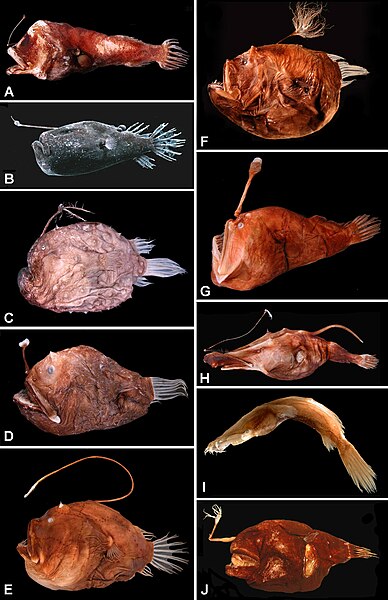The anglerfish are fish of the teleost order Lophiiformes. They are bony fish named for their characteristic mode of predation, in which a modified luminescent fin ray acts as a lure for other fish. The luminescence comes from symbiotic bacteria, which are thought to be acquired from seawater, that dwell in and around the sea.
(A) Centrophryne spinulosa, 136 mm SL (B) Cryptopsaras couesii, 34.5 mm SL (C) Himantolophus appelii, 124 mm SL (D) Diceratias trilobus, 86 mm SL (E) Bufoceratias wedli, 96 mm SL (F) Bufoceratias shaoi, 101 mm SL (G) Melanocetus eustalus, 93 mm SL (H) Lasiognathus amphirhamphus, 157 mm SL (I) Thaumatichthys binghami, 83 mm SL (J) Chaenophryne quasiramifera, 157 mm SL.
Red-lipped batfish
Striated frogfish (Antennarius striatus)
Skeleton of the anglerfish Lophius piscatorius: The first spine of the dorsal fin of the anglerfish acts as a fishing rod with a lure.
Teleostei, members of which are known as teleosts, is, by far, the largest infraclass in the class Actinopterygii, the ray-finned fishes, and contains 96% of all extant species of fish. Teleosts are arranged into about 40 orders and 448 families. Over 26,000 species have been described. Teleosts range from giant oarfish measuring 7.6 m (25 ft) or more, and ocean sunfish weighing over 2 t, to the minute male anglerfish Photocorynus spiniceps, just 6.2 mm (0.24 in) long. Including not only torpedo-shaped fish built for speed, teleosts can be flattened vertically or horizontally, be elongated cylinders or take specialised shapes as in anglerfish and seahorses.
Teleost
Skull and jaw anatomy
Caudal skeleton showing symmetrical (homocercal) tail
Aspidorhynchus acustirostris, an early teleost from the Middle Jurassic








